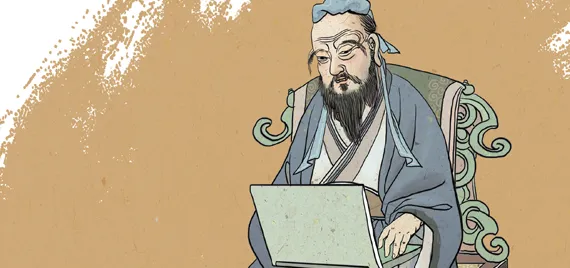This isn’t the first rebirth for Confucius
The 21st-century revival of Confucianism has been a long strange trip back to relevance for China’s most famous sage. His image is seemingly everywhere. Officials from Xi Jinping down to local Party secretaries quote the Analects in speeches. A new documentary featuring both Chinese and international scholars debuted in January on CCTV. Confucius’ hometown in Qufu has been the recipient of millions of RMB in investment to transform the Shandong city into a Confucian theme park.
At the same time, a lot of attention has been paid, deservedly so, to the ironies of venerating Confucius only a few decades after his image was burned in effigy as one of the “Four Olds” during the Cultural Revolution.
But this is not the first time Confucius has made such a comeback. A century ago, a generation of young intellectuals excoriated Confucianism. The students and teachers of the New Culture Movement began in 1915 blamed Confucianism for a host of social ills including gender discrimination, economic inequality, and political repression. This generation equated personal liberation with political and social reform, and Confucianism represented all of the obstacles in their way. To be free as an individual meant unbuckling the family shackles of the “Three Followings and Five Moral Teachings.” To be free as a nation meant liberating Chinese culture from the grip of its Confucian past.
In 1916, Chen Duxiu (陈独秀), editor of the influential New Culture journal La Jeunesse (Xin Qingnian) wrote:
“Confucius lived in a feudal age. The ethics he promoted are the ethics of a feudal age. The social mores he taught and even his own mode of living were teachings and mode of a feudal age. The objectives, ethics, social norms, mode of living, and political institutions did not go beyond the privilege and prestige of a few rulers and aristocrats and had nothing to do with the happiness of the great masses.”
Just 18 years after Chen Duxiu’s vitriolic rant against Confucius, Republic of China president Chiang Kai-shek extolled the virtues of Confucius as part of a “New Life Movement” starting in 1934. Chiang believed Confucian values could promote a more modern, disciplined, and harmonious society. The quest for personal liberation and social reform during the New Culture era had ceded primacy to a new goal: strengthening the state.
Chen’s thorough denunciation of Confucius in 1916 marked a turning point in the modern history of Confucianism. A generation before Chen’s attack on Confucianism in the pages of La Jeunesse, the reformer Kang Youwei (康有为) had reinterpreted Confucianism in radically new ways. Kang argued that if Confucius was living at the end of the 19th century, he would not have favored a preservation of ancient traditions, but would have encouraged reforms and new ideas.
Even scholars more conservative than Kang, such as the high-ranking official Zhang Zhidong (张之洞) still felt that there was a place within the Confucian tradition for new thinking from afar.
“Scholars today should master the classics in order to understand the purpose of our early sages and teachers in establishing our doctrine. They must…read the philosophers and literary collections in order to become familiar with Chinese scholarship and fine writing. After this, they can select and utilize the Western learning that can make up for our shortcomings and adopt those Western governmental methods that can cure our illness. In this way, China will benefit from Western learning without incurring any danger.”
But Chen represented a new era. The Qing Dynasty and the imperial system had been swept away by the revolution which began in 1911. Chen was was not interested in expanding what it meant to be Confucian or in reinterpreting Confucius for a modern age. He wanted to rip Confucianism out by its root. In his essay, Chen indicts Confucianism for almost every social and political ill facing China during the tumultuous years since the fall of the Qing Empire. Chen’s assumptions about what Confucianism meant were also representative of the seismic shift that occurred in the early 20th century over how Confucianism was understood in China.
Kang and Zhang, however, they might have disagreed, saw Confucianism as a set of ideas with universal application.
Kang believed that the world was moving toward a future without states or even families, but he conceived of this utopia still within the context of a Confucian “Grand Commonality.” Zhang, champion of Chinese values, still saw those values as inclusive of non-Chinese as well.
“Confucius represented the highest ideal of human relationships. He established in detail and with clarity rules of decorum based on human feelings. Although Westerners have such rules only in abbreviated form, still foreigners have never abandoned the idea of decorum. For the norm of Heaven and the nature of man are about the same in China and foreign countries.”
But at the turn of the 20th century, to be Confucian no longer meant the culture and civilization of “All Under Heaven.” Instead, it came to represent a particular culture, place and civilization. Confucianism was no longer a universal set of ideas; it had become the ideas of China and a few other East Asian states.
Chen was not attacking culture in general; he was attacking his own culture in particular. Confucianism was a stand-in, a straw man even, for all of the things Chen felt was wrong with Chinese civilization. Zhang felt China’s predicament could be fixed from within, for surely there was no other viable alternative to Confucianism. Chen wanted to blow the whole thing up because he believed there was more than one way forward.
If the New Culture Movement detached Confucianism from its universal anchor, the effort less than two decades later by the government of Chiang Kai-shek to enlist Confucianism in the service of state power robbed Confucianism of its vitality as a living and evolving set of ideas.
In his book, Confucian China and its Modern Fate, Historian Joseph Levenson paraphrases the great religious historian Jaroslav Pelikan: “Tradition is the living faith of the dead, traditionalism is the dead faith of the living. And, I suppose I should add, it is traditionalism that gives tradition such a bad name.”
Beginning with the New Life Movement and into the post-liberation era, attempts to revive Confucianism have invariably led down the path of traditionalism: The reanimation of ideas and symbols to combat threats, perceived or real, facing state and society.
In the New Life Movement, Chiang Kai-shek proposed a set of Confucian values to realize his vision of China as a disciplined, orderly, and harmonious society free from social and political upheaval. The New Life Movement with its mix of Confucian values and European fascism showed how traditionalism could be a tempting expedient for those seeking to consolidate state power. That the New Life Movement ultimately failed to generate much enthusiasm among the people revealed its inherent limitations.
In many ways, the use of Confucian traditionalism in the service of state power in the 1930s can be traced back to the New Culture era. The New Culture Movement intellectuals hated Confucianism, but their Confucianism had as little to do with the teachings of Confucius as the rants of the Religious Right in the United States have with the teachings of Jesus or the lunatic ravings of Daesh with the words of the prophet Mohammed.
In his most recent book, Out of Autocracy, Tsinghua historian Qin Hui, argues that while Confucianism won the day in the Han era, it did so at only by absorbing Legalism. Legalism had been the ideology of the Qin Empire. Legalists assumed humans were relentlessly self-interested. It was an ideology that stressed increasing state power through the careful application of laws and by harnessing people’s innate desires to receive rewards and avoid punishments. Imperial ideology in China would henceforth be a kind of autocracy, Confucian on the outside and Legalism on the inside.
The New Culture Movement, argues Professor Qin, attacked Confucianism but ignored the Legalist core. Confucianism arrived in the 20th century with a great deal of baggage, but it also contained the ideals of virtuous rule; reciprocity in relationships; and the importance of humaneness, benevolence, and empathy in governing human relationships.
A hundred years ago, the Confucian tradition began the painful evolution to traditionalism and Confucianism was never to be the same. Attempts by scholars, governments, and civic groups to revive Confucianism for modern purposes have met with mixed success. Confucianism has experienced both intense opposition and improbable comebacks over the last century. There are echoes of the New Culture era in the anti-Confucian sloganeering of the Cultural Revolution just as there are traces of the New Life Movement in subsequent revivals. The 21st-century Confucian revival carries with it the baggage of the 20th century. As the current revival gains momentum, the debate over Confucian values will continue.
“How to Reanimate a Sage” is a story from our newest issue, “Internet Celebrity”. To read the whole piece, become a subscriber and receive the full magazine. Alternatively, you can purchase the digital version from the iTunes Store.












